20 Easiest and Most Effective Exercises on the Planet

When putting together this list of the 20 easiest and most effective exercises on the planet, the team here at Best Life asked a panel of world-renowned fitness experts for the moves that have driven proven results for their clients.
And now we present those findings to you.
Each exercise is calibrated to be simple to do, take just minutes of time and provide maximum benefits, so you can build strength, improve flexibility and increase your endurance. You’ll see some old favorites proven to work, like push-ups and swimming, but also discover some new spins on the classics (such as a push-up matrix) and new-to-you techniques (such as the ELDOA stretch). So whether you’re an athlete in your fourth decade of training, or a newbie just starting out, prepare to learn the world’s easiest and most effective exercises, and get moving.
RELATED: 20 Easy Ways to Flatten Your Belly Fast, Says Top Nutritionist
Do a Classic Pushup, or Try a Push-up Matrix
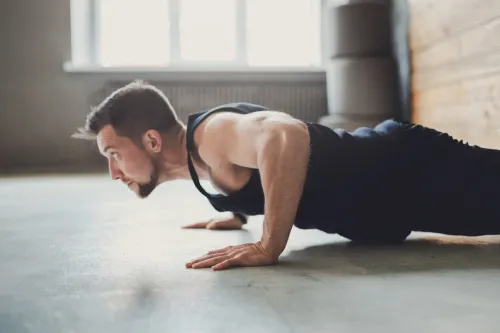
Old-school push ups are “a great way to work your upper body and are convenient since they require no equipment and can be done anywhere,” says Rachel MacPherson, Certified Personal Trainer, Certified Exercise Nutrition Specialist. “They target multiple muscles at once (chest, shoulders, core, arms), so they are super efficient for building strength. Plus, you can easily adjust them to your fitness level by adjusting the incline of your hands/torso (higher torso slant is easier, higher feet/lower torso slant is harder).”
Or amp up the move with a new twist. “The push-up matrix is highly beneficial because it works all three fiber orientations of the chest while also working all three heads of the tricep muscles,” says TJ Pierce, owner and head therapist at Pierce Family Wellness, who has recommended the matrix before as one of our best bodyweight exercises you can do anywhere. In that article, he added that the exercise “involves somewhere between 50 and 65 repetitions so it ensures that you work all muscle fiber types.” Pierce says the benefits “include working all the fibers of the pectoralis major/minor and triceps muscles,” in addition to “working type one and type two muscle fibers. It also works the core, and provides a stretching and a pumping of the pericardial tissue.”
How to Do it: “The push-up matrix consists of three major arm positions: internal rotation, neutral, and external rotation. These positions are performed above the clavicle, parallel to the clavicle, below the clavicle, and then one hand above while the other is below the clavicle.” See the video above, or here, for how to do the move.
Best Life Tip: “Avoid creating too much internal or external rotation so that you do not create a shoulder impingement. Avoid reaching the head forward at the bottom of the push-up. And perform them on your knees until you have the strength to properly perform them from your feet,” says Pierce.
Do a Short Hinged Oblique
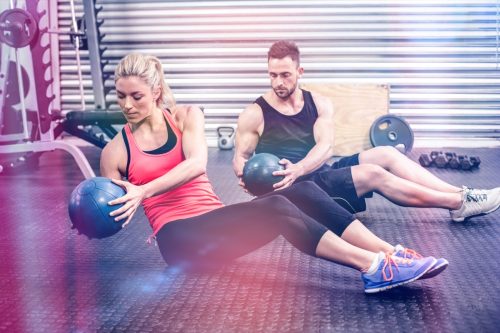
Similar to a Russian Twist, “the short hinged obliques work, the rectus abdominis, internal oblique, external oblique and transverse abdominis all in one movement,” says Pierce. “This is a great abdominal exercise as it not only builds muscle and endurance in all the abdominal muscles, but provides a pumping of all the abdominal organs.”
How to Do it: “Begin by lying on your back, squeeze your feet, knees, and thighs together. Place your hands on your ears, chest or out in front of you for the beginners. All at the same time sit up while rotating your torso in one direction and your hips in the opposite direction. With control, lower yourself back to the starting position and repeat to the other side.”
Best Life Tip: “Avoid going too fast so you do not hurt your back. Avoid trying to do too big of a range of motion if you are a beginner. To alter the range of motion, start at the top and only go down a quarter to halfway before coming back up and repeating on the other side,” says Pierce.
RELATED: 20 Ways to Eat Your Favorite Foods and Still Lose Weight
Do Wall Sits, Segmental

“The wall sit with segmental positioning of the legs works all four fiber orientations of the glute maximus muscle,” says Pierce. “This exercise works all of the leg muscles and as an added bonus is scientifically proven to lower blood pressure.”
How to Do it: “Begin by putting a small stool or a medicine ball on the ground below you so that if you need to come out of the exercise, you can gently slide down the wall onto a seat. Begin with your feet together and your knees together and squat down the wall to roughly 90° angles at your knees, hips and ankles. hold that position anywhere between 20 to 60 seconds. Then keep your feet together and push your knees apart. Repeat for the set time. Next keep your knees together and walk your feet out about shoulder with apart hold for the desired time. Lastly, have your feet shoulder with apart and your knees shoulder with apart again hold for the desired time. at the end of the exercise gently slide down the wall onto your seat.”
Best Life Tip: “Avoid trying to hold each position too long if you are a beginner. Avoid squatting down past 90°. Avoid squatting to 90° if you have any knee or hip pain,” says Pierce. A regular old Wall Sit is also very effective. “A wall sit activates your quadriceps (front of your upper thighs) as well as your glutes, hamstrings, inner thighs, and core. Whether you’re taking a screen break or checking your phone, this is a simple exercise to get multiple muscle groups fired up at the same time,” says Dilan Gomih, a fitness specialist, Chief Exercise Officer, and Founder of a black woman-owned business, Dilagence. How to Do it: “Find a flat wall and stand with your back against it. Lower into a seated position with your knees at a 90-degree angle. Keep your back flat against the wall and hold for 30 seconds (or more!) Focus on breathing and push through your heels,” says Gomih.
Do a Prone Back Extension with Rotation
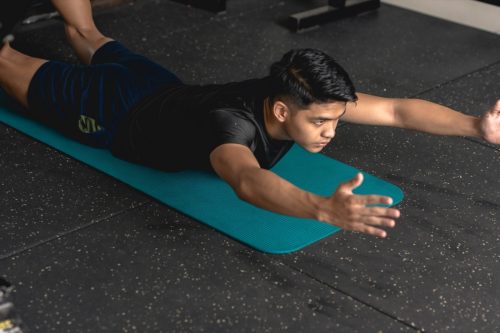
“By performing extension and rotation from a prone position you work all of the spinal extensor muscles,” says Pierce. “Because these muscles are the first to be innervated by the spinal cord, exercising these muscles creates a relaxation effect in the central nervous system. This exercise strengthens all of the spinal muscles in what’s considered the internal or most functional range. This exercise also increases proprioception or awareness of all of your spinal extensor muscles.”
How to Do it: “Lie on your stomach with your hands stacked on top of each other and your head stacked on your hands. Without letting your hands actually move, imagine you’re going to try to slide your hands apart to create some tension. Imagine your forehead is glued to your hands so that when you do start to lift, your neck does not go into extension. Curl your toes and bend your ankles back, keeping your knees straight. Stack one leg on top of the other. Once you are set up, you will simply lift your arms and legs at the same time while rotating your torso in one direction and your pelvis in the opposite direction of the top leg.”
Best Life Tip: “Avoid doing too many reps if you are a beginner. Avoid trying to lift too high if you are a beginner. Avoid if you have a current stenosis or spondylolysis.”
Try ELDOA, a Clever Spin on Stretching
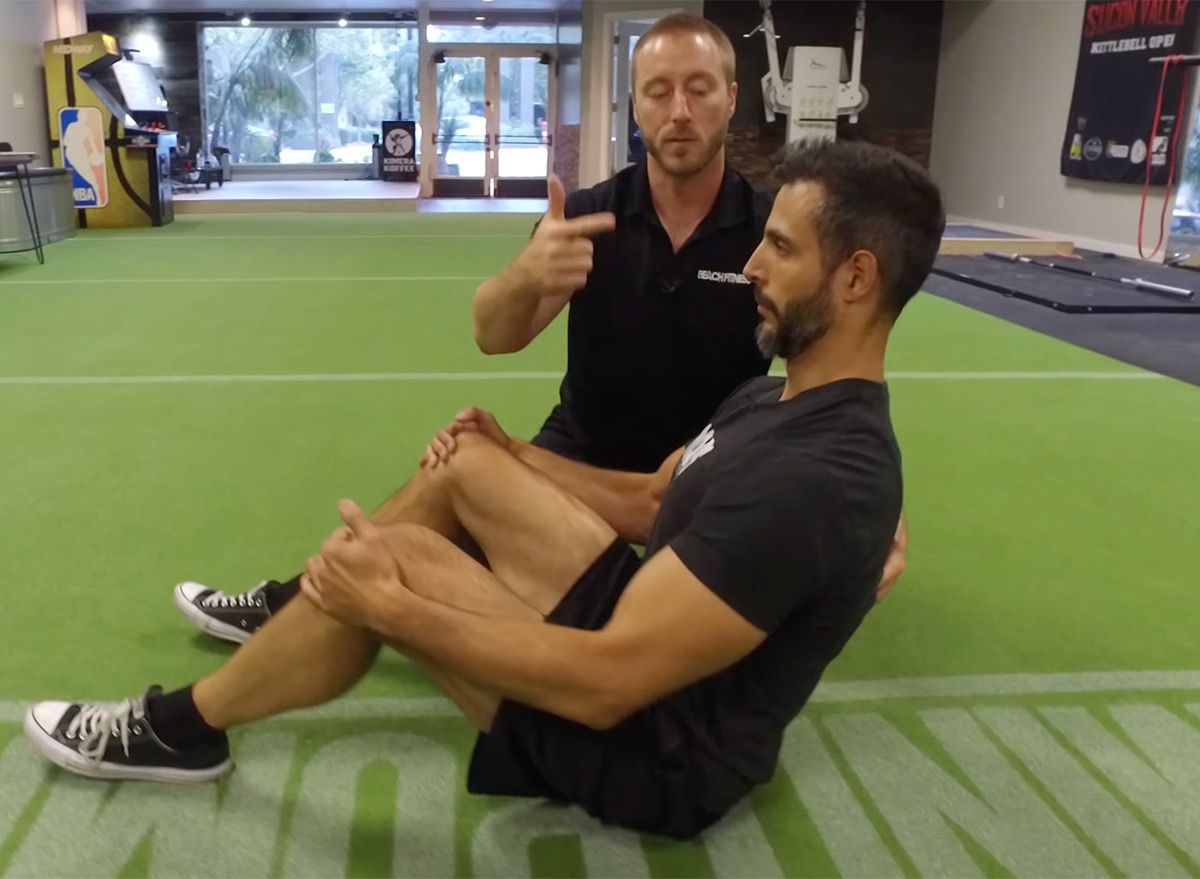
An enhanced stretch, “the ELDOA exercises improve general posture while increasing strength of the spinal muscles,” says Pierce. They “can also help increase space between vertebrae and have been shown to decrease pain while improving overall well-being.” (What does ELODA stand for, anyway? “Étirements Longitudinaux avec Decoaptation Ostéo-Articulaire,” which is French for “Longitudinal Osteo-Articular Decoaptation Stretching.” They were developed by a French osteopath.)
How to Do it: See the video above, or here, for an example. “General rules for the ELDOA exercise are: Create as much spinal extension as possible by gently, tucking your chin in and pushing your head gently back. On both arms spread the fingers and bend the wrist back, straighten the elbows and externally rotate the shoulder girdle. Slowly reach the arms up over your head and stretch to the ceiling. make sure to keep your jaw relaxed, and your belly relaxed throughout the exercise. Hold each ELDOA for 60 seconds.”
Best Life Tip: “Avoid pushing too hard early on if you are a beginner. It is important to learn factors of progression, which would include, but are not limited to, reaching the arms only halfway, starting with your back against the wall.”
RELATED: 8 Best Ways to Strip Away Your Unhealthiest Belly Fat
Do Tricep Dips
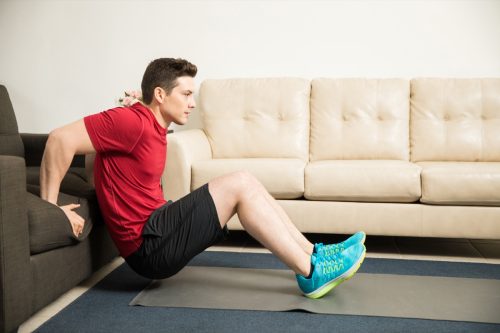
“This move primarily works your triceps brachii (the back of your upper arms). It also engages your shoulder, chest, and core which help to stabilize the rest of your body during the movement,” says Gomih.
How to Do it: “Sit on the edge of a sturdy chair. Place hands next to hips with fingers facing forward. Slide off the edge and lower your body until your elbows are bent at a 90-degree angle, then push back up. Try doing 30 seconds of reps, holding for 10, and pulsing for 10 and you should feel this in the backs of your arms!”
Best Life Tip: “Keep your body fairly close to the chair.”
Do a Standing (or Seated) Spinal Twist
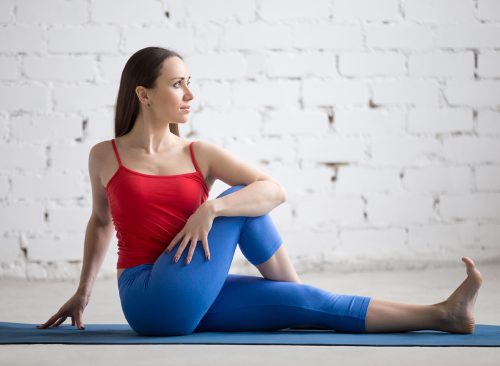
“This move improves flexibility and mobility of your spine as well as your shoulder muscles,” says Gomih.
How to Do it: “Start by sitting on the floor, with your legs straight out in front of you and your arms behind your back. Place your hands on the floor behind you with your fingers facing away from you. Take your left foot and place it flat on the ground on the outside of your right knee. Inhale and bring your right arm up. Exhale and pull your right arm down. Place your elbow on the outside of your left leg. Turn your chest, head and eyes to the left. Hold this pose for about a minute. Breathe. Slowly bring your head first and then your chest back to center. Now repeat on the other side,” says the Mayo Clinic.
Best Life Tip: “Lots of people feel like it’s hard to find time to stretch, but taking even 30-60 seconds to do this stretch can be a powerful way to alleviate tension that can build up from staying in a static position. Try challenging yourself to do this 3-5 times a day or stretch after meetings. Remember, the stretch isn’t about speed! Stretch slowly and never force the stretch past your comfort.”
Do Deadlifts
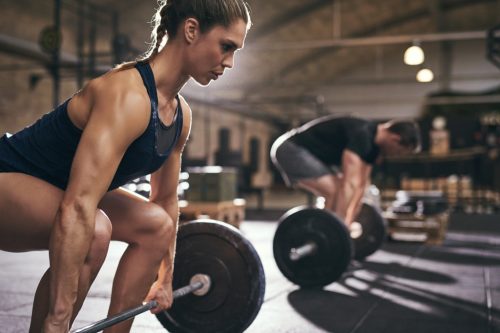
“Deadlifts are a great exercise for building strength since they mimic natural movements like bending over (hinging) and target several muscle groups all at once, including your back, hips, glutes, hamstrings, and core. Using variations like the sumo deadlift, you can tweak the exercise to focus on different muscles so your workouts stay fresh and continue to challenge you in new ways,” says MacPherson.
How to Do it: Begin by standing with your feet hip-width apart, toes under the barbell. Bend at your hips and knees to grip the bar with hands shoulder-width apart, either in an overhand or mixed grip. Keep your back straight and chest up as you lift the bar by extending your hips and knees. The bar should stay close to your legs throughout the lift. Once upright, lower the bar back to the ground by bending at the hips and controlling the descent.
Walk
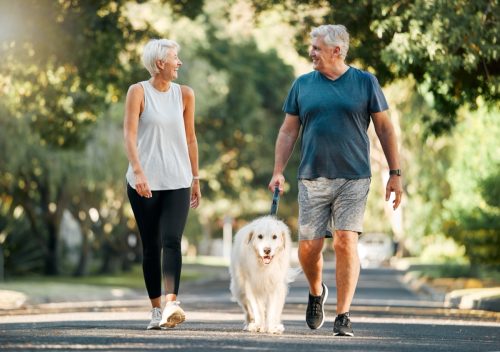
“Walking is a simple, low-impact exercise that boosts heart health, weight management, and mood. It’s accessible and requires no equipment, so it’s a fantastic option for people of any fitness level. Plus, you get fresh air and vitamin D, which is another reason walking is so good for mental health,” says MacPherson.
Adds Peter Conroy, Founder of The Difference App: “Regular walking offers a transformative journey toward overall well-being, enhancing longevity and diminishing the risks of chronic ailments. Achieving this is as simple as dedicating 150 minutes per week to moderate exercise. This activity not only benefits the heart by warding off cardiovascular issues like heart disease, high blood pressure, and stroke but also enhances joint flexibility, muscle tone, and bone strength, promoting optimal musculoskeletal health. Moreover, walking extends its reach beyond physical advantages, fostering tranquility, elevating energy levels, facilitating better sleep and digestion, and fostering a revitalizing connection with the natural world. As a potent driver of mental wellness, it alleviates stress, anxiety, and depression through the release of mood-enhancing endorphins. By embracing walking, we empower ourselves to lead enriching lives filled with vitality, resilience, and a profound sense of well-being.”
Best Life Tip: You don’t have to go too far. “Taking a walk around your neighborhood or exploring local trails is a great way to improve your mental and physical health while connecting with nature (another mood booster),” says MacPherson.
Swim
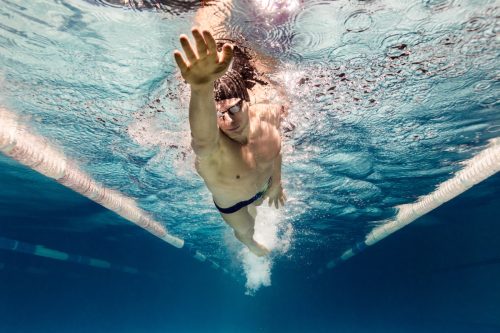
“Swimming is a low-impact, full-body workout that’s perfect for all ages and fitness levels. It increases your heart rate, builds muscular and cardiovascular endurance, and is gentle on your joints due to the resistance of the water and a decrease in the effects of gravity. Try breaststroke, backstroke, or freestyle for a varied full-body cardio and strength training session,” says MacPherson.
Try Rucking
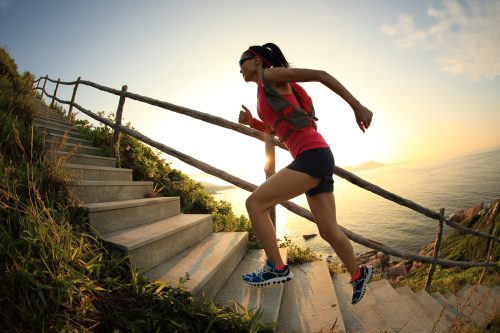
“Rucking is a simple yet effective workout that is done by adding weight to your backpack and going for a walk or hike (usually outdoors, but can also be done on a treadmill),” says MacPherson. “It’s an adaptable workout that can be adjusted for any fitness level to increase endurance and strength. Rucking is able to be done on the sidewalk in your neighborhood or on challenging hiking trails to turn walking into full-body workouts.”
Do a Suitcase Carry

“The suitcase carry is a simple, functional, and effective exercise that you can easily incorporate into your daily activities,” says MacPherson. “It’s similar to carrying heavy bags like groceries, or of course, a suitcase. It builds core strength, improves posture, and works your grip and shoulders. You can grab any weighted object and walk with it for a quick mini-workout without hitting the gym.”
Try a Pallof Press
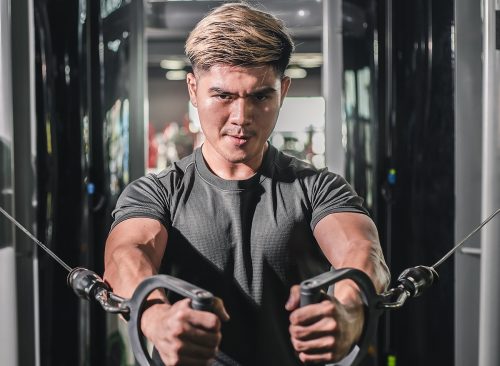
“The Pallof Press is a core exercise that builds stability and strength by resisting rotation,” says MacPherson. “It’s versatile, safe, and effective for daily activities and sports, and it’s also gentle on the spine.”
How to Do it: Stand perpendicular to a cable machine or resistance band anchored at chest height. Hold the handle or end of the band with both hands directly in front of your chest, keeping your feet shoulder-width apart. Brace your core and slowly extend your arms straight in front of you, without letting your torso twist or rotate. Hold the position briefly, then slowly return your hands to your chest. Repeat for the desired number of repetitions, then switch sides to ensure balanced training.
Do a Plank Rock
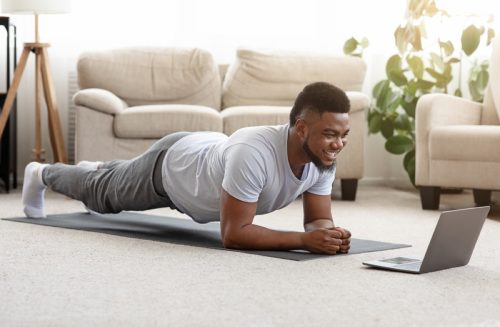
The Plank Rock “works the entire body while building strength and control in the upper body, creating range of motion in the ankles and stretching the calves,” says Portia Page, NCPT, a Balanced Body Educator who has been a Pilates teacher for the past 20 years and in the fitness industry for over 30 years.
How to Do it: “Come to the floor on all fours with the knees under the hips and the hands under the shoulders. Straighten one leg, then the other, keeping the back long and straight. Rock forward on the toes and back to bring the heels forward and back while keeping the spine long and straight. Repeat the rocking back and forth for 1-minute.”
Best Life Tip: “Challenge: As you rock forward on the toes, lift 1-leg up with the toes pointed (plantar-flexed) and pulse 3-6 times (pulsing forward back on 1-foot, while pulsing up/down with the lifted leg. Ultra Challenge: With the pulsing and leg lift, add the opposite arm either to the side, back, or overhead (like Superman/woman😊).”
Do a Squat/Heel Lift
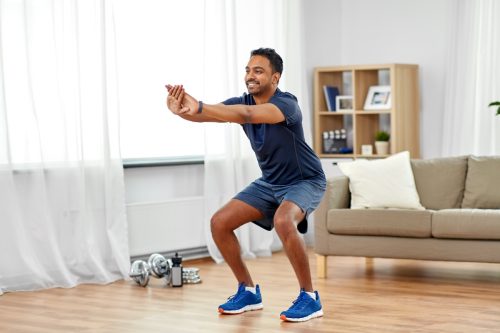
This move “strengthens the legs, glutes, hips and ankles as well as tones and shapes the thighs, hamstrings and calves,” says Page.
How to Do it: “Stand with the feet outside of the hips and the arms by the sides of the body. Sit back and down by bending the knees, hinging at the hips and reach the arms chest height with the thumbs up. Straighten the legs and unhinge the hips, taking the arms to the sides. Once upright, lift the heels and press the arms back behind the hips. Repeat as many controlled repetitions as possible for one minute.”
Best Life Tip: “Challenge: After a few repetitions of sitting back and down and lifting the heels as the legs straighten, add a lift off of the whole foot (i.e., jump up and land soft). The jump can be small (just a micro lift), OR you can reach for the sky and jump high. This adds plyometrics and cardio to your exercise routine and is really great for building strength in the legs and glutes while increasing the cardiovascular benefits.”
Do a Lunge Drop/Forward
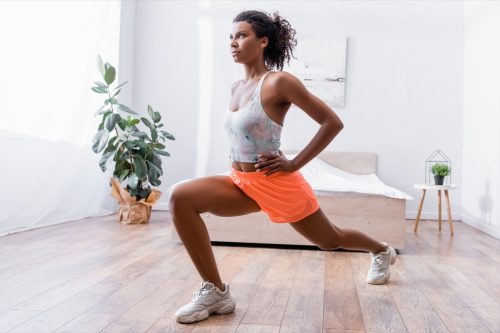
The Lunge Drop/Forward “strengthens the legs and builds control and stability around the hips and glutes while enhancing balance in a split stance,” says Page.
How to Do it: “Stand with the feet under the hips and toes facing forward, arms by the sides. Take a long step behind with one foot and bend both knees while raising the arms to shoulder height with the thumbs up. Keep the head over the ribs, over the hips, over the back knee while keeping the front knee over the ankle. Straighten the back leg as the arms move back and while hinging forward over the hips to bring the chest over the front thigh. Keep the back heel up. Repeat down and forward for 30-seconds and then switch sides.”
Best Life Tip: “Challenge: After 30-seconds of bending and straightening the back leg, hold in the forward tilt position and lift and lower the back leg to hip height weight hinging the torso more forward. After 30-seconds of this, hold the balance and either hold everything still for 30-seconds, Or move the arms and challenge your balance.”
Do a Bridge/Crunch
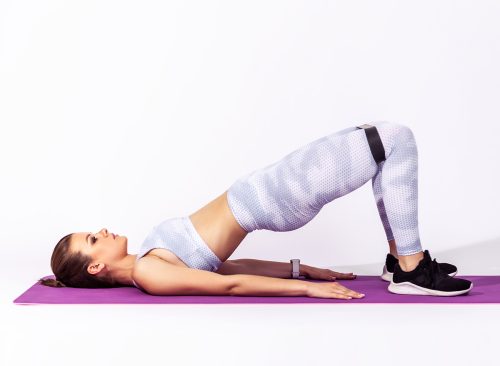
Page swears by the classic bridge/crunch, which she says “strengthens the entire core (abdominals and back) while enhancing the posture muscles for sitting and standing.”
How to Do it: “Lie on the back with the knees bent, feet flat, in line with the sit bones, arms to the sides with the palms up. Press into both feet and lift the hips up towards the ceiling making a straight line between the shoulders and the knees (Bridge). Keep the arms and back of the head pressing into the floor. Lower the hips down to the floor and then lift the head, chest and shoulders up while bringing both knees about the hips (Crunch). Look between the thighs with the eyes while keeping the chin away from the chest. Lower the head, arms and feet and repeat the Bridge to the Crunch for 1-minute.”
Best Life Tip: “Challenge: At the top of the Bridge (i.e., hips up), alternate leg lifts (4-6 sets). At the top of the Crunch (i.e., head up), add abdominal pulse, or alternating knee lifts with the head up, and/or both😊!”
Do a Single Leg Deadlift/Row
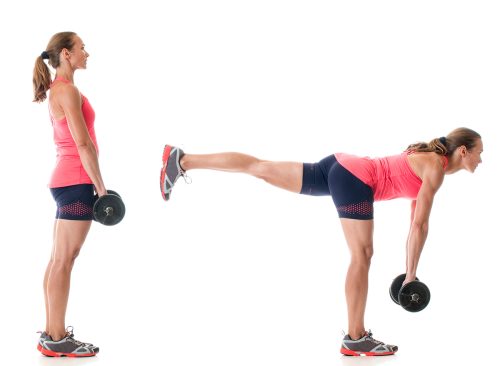
The Single Leg Deadlift/Row “strengthens the lateral (side) hip, enhances balance on 1-leg and helps to work to mid and upper-back for better posture,” says Page.
How to Do it: “Stand with the feet under the hips, arms by the side and all 10 toes facing forward. Hinge at the hips while lifting one leg behind the hips. Reach the arms towards the floor while keeping the back straight. Keep the head, trunk, and leg being lifted in one long straight line. Bend both elbows up and to the sides of the shoulders by squeezing the shoulder blades together and behind the back. Keep the lifted leg hip height with the toes pointed down to the floor and bend and straighten the arms 5-10 times. Return to a standing position and repeat on the other side. This can be repeated 1-3 sets.”
Best Life Tip: “Challenge: Holding the leg up at hip height (toes pointed down), bend your elbows and take the fingers behind the head keeping the elbows in the peripheral vision, rotate just the torso (ribs to head/arms) toward the right and left. After 4-5 sets, let the pelvis also rotate (rotating the leg, pelvis, and torso over the standing hip. Talk about a ‘cool hip stabilizer – guaranteed to feel the burn😊’!”
Run Bleachers

“One of my favorite workouts in the off season is running bleachers in a stadium! Gets the heart rate up and gives you a nice calf and booty burn plus you’re able to go at your own pace!” says Anicka Newell, Canadian Olympic Pole Vaulter.
How to Do it: “The best way to do it is try and sprint up the steps, or walk.”
Surprisingly, Chores are an Effective Workout, Too!
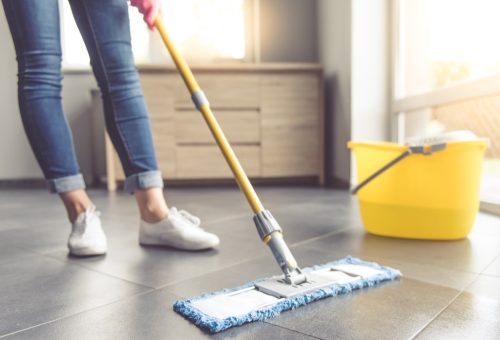
“Doing chores around the house can double as an exercise routine because when you are vacuuming or scrubbing the bathroom, you’re moving your body in different planes of motion, which can help improve your flexibility and even build some functional strength,” says MacPherson.
Best Life Tip: “You can make it more fun and challenging by setting a timer and seeing how much you can get done in a set period or incorporating mini exercise breaks with squats or lunges between tasks.”